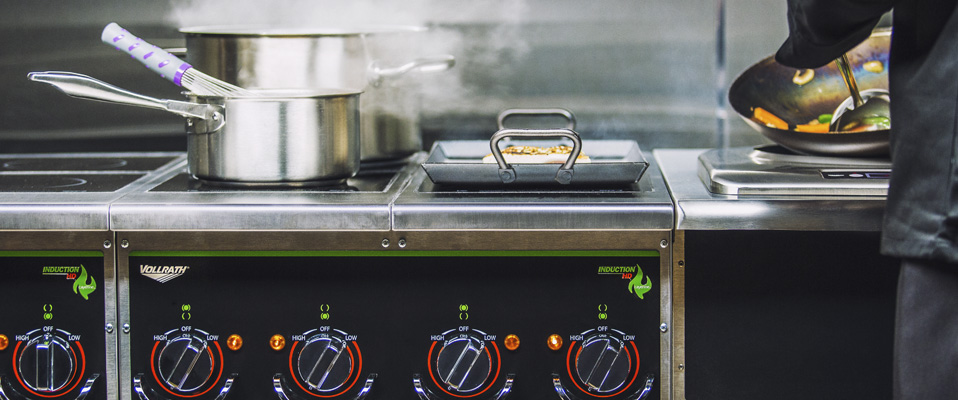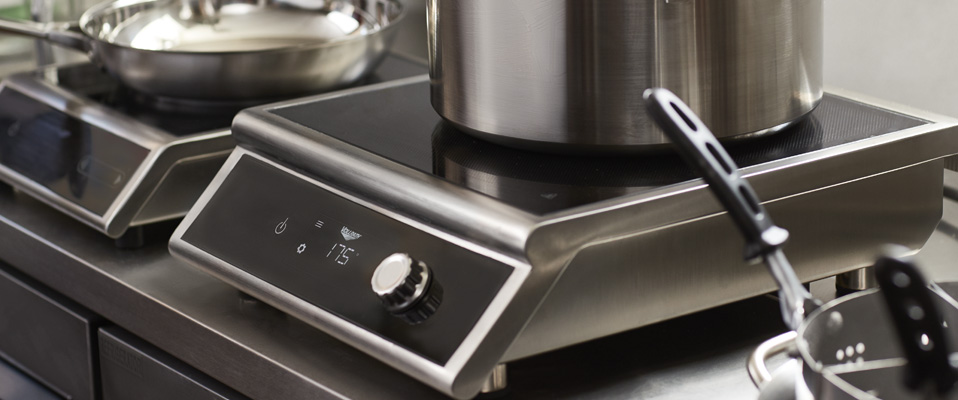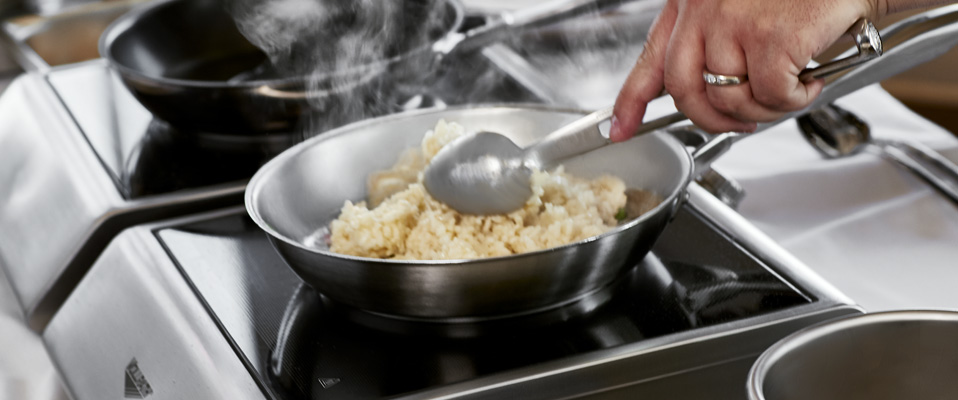How to Choose the Right Commercial Induction Range for your Foodservice Operation

Once you make the commitment to use induction in your foodservice operation, choosing a commercial induction range can be stressful. There are so many commercial induction ranges available from very inexpensive imported units to very expensive full-size ranges. How do you know which range is right for your foodservice operation? To help ease the stress of choosing a unit, let’s talk about what you need to know to select the correct induction unit for your operation.
Drop-In vs Countertop
The first choice you need to make is whether you going to use a cooktop that is built into a counter, or a drop-in range. Or, are you going to use an induction cooktop that sits on the counter, a countertop range?
What are Induction Drop-in Ranges?
Drop-in induction ranges are popular because they are built-in to a counter and appear to be part of the environment. They typically are flush with the countertop, so they are easy to clean. The controls are mounted into the face of the counter below the countertop, so they are readily accessible.

A drop-in induction unit cannot be picked up and carried to another room. The unit will only move if the counter it is built into is mobile. And, if a drop-in unit needs to be repaired or replaced, the unit usually needs to be removed from the counter.
What are Commercial Induction Countertop Ranges?
Induction countertop ranges are nice because they sit on top of the counter and, depending upon wattage of the unit and weight, can easily be moved from counter to counter giving the operator flexibility regarding where the unit is used. Countertop units vary in size, the biggest concern for an operator is setting the cooktops on a counter height that allows for comfortable cooking. Countertop ranges are also very easy to repair or replace.

What size commercial induction range do I need?
The next decision you need to make is selecting a properly sized unit. Commercial induction ranges are available in wattages as low as 300 watts for holding food up to 5,000 watts for stock pots or heavy-duty cooking. Your perfect size lies somewhere in this spectrum. The tips below should help you choose the correct size induction unit for your operation.
What are you cooking?
If you are using an induction burner to cook omelets in front of guests, you do not need the same size unit as someone who is using induction to hold food, or someone who is preparing soups for a large catered event. The chart below will help you select the correct induction unit, based upon wattage of the unit vs what you are cooking.
- 300 – 1250 watts – Great for holding food.
- 1400 - 1800 watts - Great for sautéing, searing, warming and all front-of-house applications.
- 2600 – 3800 watts - Great for boiling, simmering sauces, stocks, deep frying, and all back-of-house applications.
What you are cooking plays a very important role in selecting the correct commercial induction cooktop for your foodservice operation.
Is speed a concern?
How fast you need the food to cook can also play a role in selecting an induction cooktop. A higher-wattage range cooks food faster than a lower-wattage range. But as with everything else, speed of cooking needs to be taken into consideration with the other factors discussed on this section.
Size of the pan
The size of the plan you will be using on the range may also play a factor in selecting the correct unit. As we all know with induction, heat is generated in the pan when a magnetic connection is made between the induction unit and the pan. If the pan overhangs the induction unit, the part of the pan overhanging the unit will not generate heat, possibly slowing down the heating process.

Electrical Available
You also need to consider what electrical you have available. The higher-wattage units move from 120 volts to 208 volts. Not all facilities have 208 voltage available. Ensure you have the voltage available for the unit you select. If you select a 208 volt unit, do you need an electrician to install the correct NEMA plug for your new unit? Be aware of the electrical requirements for the unit you select.
Certifications
Any induction unit being used in a commercial establishment should have NSF, UL, and FCC certifications listed on the unit. These certifications ensure that the unit has been properly tested and is safe for you, your employees, and your establishment. What are these certifications?
- NSF – National Sanitation Foundation – Ensures the unit meets all sanitation requirements, allowing for proper cleaning of the unit. A UL Sanitation or ETL Sanitation Mark may be also acceptable in your jurisdiction, check with your local health department to be sure.
- UL – Underwriter Laboratories – UL sets the standards for electrical appliances and tests units to ensure the unit performs as designed and is safe from an electrical perspective. Again, an ETL Mark may be acceptable in your jurisdiction, check your local building codes to be sure.
- FCC – Federal Communications Commission – The FCC mark certifies that the electromagnetic interference of the induction unit is under the limits approved by the FCC. This certification is often overlooked on induction units for cost reasons but is actually very important to keep your induction unit safe from electrical “noise” common on transmission lines.
Components
The last item to consider is the quality of the componentry in the induction unit. Quality components will extend the life of your unit and improve your cooking capability. The componentry affects the size of the magnetic field, pan detection, cooking speed, energy efficiency, and temperature control. Do not be afraid to ask questions.
My last piece of advice is to think of your induction unit and the pan(s) you will be using on it as a system. With a good system, everything works as designed. If one piece of the system is substandard, the system will not function properly. As you do your research looking for the perfect induction unit, also research the best pans to use on the unit. You need a good connection to complete the system.
Good luck in your search for the perfect induction unit. Do not be afraid to ask questions or ask for a demo. Cooking is your life, don’t take chances investing in the wrong unit!





